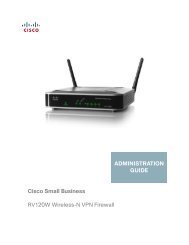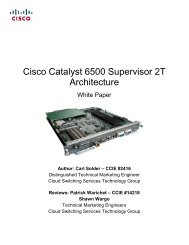Cisco WAP200 Wireless-G Access Point with PoE and ...
Cisco WAP200 Wireless-G Access Point with PoE and ...
Cisco WAP200 Wireless-G Access Point with PoE and ...
You also want an ePaper? Increase the reach of your titles
YUMPU automatically turns print PDFs into web optimized ePapers that Google loves.
<strong>Wireless</strong>-G <strong>Access</strong> <strong>Point</strong> <strong>with</strong> Power Over Ethernet <strong>and</strong> RangeboosterChapter 1: IntroductionWelcomeThank you for choosing the <strong>Wireless</strong>-G <strong>Access</strong> <strong>Point</strong> <strong>with</strong> Power Over Ethernet <strong>and</strong> Rangebooster. This <strong>Access</strong><strong>Point</strong> will allow you to network wirelessly better than ever.How does the <strong>Access</strong> <strong>Point</strong> do all of this? An access point allows for greater range <strong>and</strong> mobility <strong>with</strong>in yourwireless network while also allowing you to connect the wireless network to a wired environment. In fact, the<strong>Wireless</strong>-G <strong>Access</strong> <strong>Point</strong> <strong>with</strong> Power Over Ethernet <strong>and</strong> Rangebooster can support communications on up to fourwireless networks, using Virtual Local Area Network (VLAN) technology.The <strong>Wireless</strong>-G <strong>Access</strong> <strong>Point</strong> <strong>with</strong> Power Over Ethernet <strong>and</strong> Rangebooster also offers the convenience of Powerover Ethernet (<strong>PoE</strong>) capability, so it can receive data <strong>and</strong> power over a single Ethernet network cable. You caneven connect wired networks in two different buildings, by using two <strong>Access</strong> <strong>Point</strong>s set to <strong>Wireless</strong> Bridge mode.But what does all of this mean?Networks are useful tools for sharing computer resources. You can access one printer from different computers<strong>and</strong> access data located on another computer's hard drive. Networks are even used for playing multiplayer videogames. So, networks are not only useful in homes <strong>and</strong> offices, they can also be fun.PCs on a wired network create a LAN, or Local Area Network. They are connected <strong>with</strong> Ethernet cables, which iswhy the network is called “wired”.PCs equipped <strong>with</strong> wireless client cards or adapters can communicate <strong>with</strong>out cumbersome cables. By sharingthe same wireless settings, <strong>with</strong>in their transmission radius, they form a wireless network. This is sometimescalled a WLAN, or <strong>Wireless</strong> Local Area Network. The <strong>Access</strong> <strong>Point</strong> bridges wireless networks of both 802.11g <strong>and</strong>802.11b st<strong>and</strong>ards <strong>and</strong> wired networks.Use the instructions in this Guide to help you connect the <strong>Access</strong> <strong>Point</strong>, set it up, <strong>and</strong> configure it to bridge yourdifferent networks. These instructions should be all you need to get the most out of the <strong>Access</strong> <strong>Point</strong>.access point: a device that allows wireless-equippedcomputers <strong>and</strong> other devices to communicate <strong>with</strong> eachother <strong>and</strong> <strong>with</strong> devices on a wired network. Also used toexp<strong>and</strong> the range of a wireless network.network: a series of computers or devices connectedtogether.lan (local area network): the computers <strong>and</strong> networkingdevices that make up your local network.poe (power over ethernet): a technology enabling anEthernet network cable to deliver both data <strong>and</strong> power.ethernet: network protocol defined in IEEE 802.3 st<strong>and</strong>ardthat specifies how data is placed on <strong>and</strong> retrieved from acommon transmission medium.adapter: a device that adds network functionality to yourPC.802.11g: a wireless networking st<strong>and</strong>ard that specifies amaximum data transfer rate of 54Mbps, an operatingfrequency of 2.4GHz, <strong>and</strong> backward compatibility <strong>with</strong>802.11b devices.802.11b: a wireless networking st<strong>and</strong>ard that specifies amaximum data transfer rate of 11Mbps <strong>and</strong> an operatingfrequency of 2.4GHz.Chapter 1: IntroductionWelcome1
















